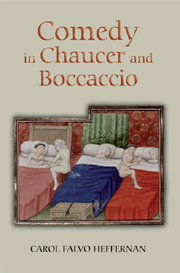Book contents
- Frontmatter
- Contents
- In memory Of Thomas Farel Heffernan 1933–2009
- Preface and Acknowledgments
- 1 Introductory matters
- 2 The Comic Inheritance of Boccaccio and Chaucer
- 3 Parallel Comic Tales in the Decameron and the Canterbury Tales
- 4 Antifraternal Satire in Boccaccio and Chaucer
- 5 Adding Comedy: Boccaccio's Filostrato and Chaucer's Troilus and Criseyde
- Conclusion
- Bibliography
- Index
- Chaucer Studies
Preface and Acknowledgments
Published online by Cambridge University Press: 12 September 2012
- Frontmatter
- Contents
- In memory Of Thomas Farel Heffernan 1933–2009
- Preface and Acknowledgments
- 1 Introductory matters
- 2 The Comic Inheritance of Boccaccio and Chaucer
- 3 Parallel Comic Tales in the Decameron and the Canterbury Tales
- 4 Antifraternal Satire in Boccaccio and Chaucer
- 5 Adding Comedy: Boccaccio's Filostrato and Chaucer's Troilus and Criseyde
- Conclusion
- Bibliography
- Index
- Chaucer Studies
Summary
It has been said that tragedy appeals to those who feel and comedy to those who think. The complete works of Chaucer (1342?–1400) and Boccaccio (1313–1375) contain enough of each genre to satisfy the tastes of both kinds of readers. The measure of the artistry of the two medieval poets can only be appreciated by studying the full range of their writing. Without intending to elevate the comic works of Chaucer and Boccaccio above the rest, this book focuses on their comic tales. Chaucer wrote his late in his career when he had the power of someone who had found his true voice and knew fully how to use it. Boccaccio's comic tales were written midway in his life; he began writing his great narrative masterwork in 1350, shortly after the Black Death struck Florence (1347–49). Chaucer and Boccaccio are borrowers of tales told by others. Part of their art is to know how to select tales that suit their styles and that they can better. Judging from the owners of the extant Decameron manuscripts, Boccaccio's collection appealed to the merchant class. When Chaucer wrote his second masterpiece, the Canterbury Tales, he clearly had in mind a broader audience than that for which he wrote his first, Troilus and Criseyde, a courtly narrative.
Comedy in Chaucer and Boccaccio examines the relationship of the comic tales – the so-called fabliaux – in Chaucer's Canterbury Tales and Boccaccio's Decameron. There is surprisingly little direct study of the comic in Boccaccio and Chaucer. The present book advances the view that not only did Chaucer and Boccaccio share the same comic literary tradition stretching back into antiquity but that Chaucer drew on the Italian’s work.
- Type
- Chapter
- Information
- Comedy in Chaucer and Boccaccio , pp. ix - xiiPublisher: Boydell & BrewerPrint publication year: 2009



